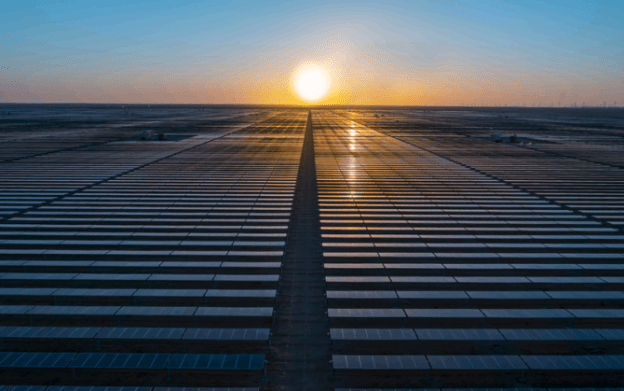Recently, news spread on the Internet that the price of polysilicon is experiencing “an avalanche”. However, Tongwei Group and other polysilicon giants have responded that the price of polysilicon has remained stable, and the factories are producing and selling at full capacity. According to the data released by PV Infolink, polysilicon price has dropped for two weeks, from peak price 310 yuan/kg to 295 yuan/kg, down by 4.84%.

Analysts believe that the turning point of polysilicon price is around the corner as new production capacity will be released in 2023.
According to Changjiang Securities, the designed capacity of polysilicon will reach 1.24 million tons by the end of 2022 and 2.54 million tons by the end of 2023. It is estimated that in 2023, the polysilicon output will reach about 1.5 million tons. It could allow the installation of 480 GW of solar projects, and the supply will be sufficient.
As the supply and demand are becoming balanced, it will be inevitable for polysilicon price to drop.
However, will there be “an avalanche” in the price? Solarbe analysts believe that the possibility is small on the premise of stable growth of market demand.
The polysilicon industry has seen three major slumps in history, and the sharp drop in demand is the core reason. Besides, “an avalanche” in prices has only occurred once in 2008 to 2009, while the other two times were slow declines in one to two years.
A slump of 92% in 2008-2009
In the first decade of the 21st century, stimulated by Germany’s Renewable Energy Sources Act (EEG 2000), Spain’s fixed feed in tariffs for renewable energy, Italy’s subsidies for PV power generation and other policies, the solar PV market in Europe and the global solar industry have boomed.
According to SolarPower Europe, from 2000 to 2008, the cumulative installed capacity of solar PV globally has increased from 1.28 GW to 15.84 GW, with a compound growth rate of 43.38%.
With the sharp increase of market demand, the price of polysilicon has soared from US$9/kg in 2000 to US$500/kg in Q3 2008, up 56 times.
However, in the fourth quarter of 2008, global solar installations have slowed down significantly in the financial crisis.
According SolarPower Europe, 7.34 GW of solar PV was installed globally in 2009, with a growth rate of only 10.21%.

At the same time, with the surge in market demand and the soaring price of polysilicon, the polysilicon sector set off a wave of production expansion in 2006-2007.
Data shows that polysilicon production capacity in 2007 was only 5,000 tons, while it has surged to 25,000 tons and 45,000 tons in 2008 and 2009.
Affected by the sharp drop in demand and the surge in supply, the price of polysilicon plummeted 92% from the peak price US$500/kg in Q3 2008 to US$40/kg in Q1 2009.
A slow drop of 75% in 2011-2012
In 2010, with the impact of the financial crisis gradually fading away, the European market has fully recovered, which has brought the global PV market back to the track of high growth.
According to SolarPower Europe, from 2010 to 2011, 17.15 GW and 30.13 GW of solar PV capacity were added globally, up 134% and 76% respectively.
As a result, the price of polysilicon rebounded rapidly, rising from US$40/kg in Q2 2010 to US$90/kg in Q3 2010, up 125% in a single quarter. However, the surge has only lasted for one quarter. By Q1 2011, the price has remained between US$70-80/kg.
At that time, the solar PV industry mainly relied on subsidies. After more than a decade of rapid growth, authorities in Germany, France, Italy and other major solar markets began to gradually reduce subsidies from 2011.
Since 2012, the United States and Europe have both began imposing anti-dumping and countervailing duties against Chinese PV products, resulting in a sharp decline in global demand for solar PV installations.
According to SolarPower Europe, 30.04 GW of solar capacity was added globally in 2012, a year-on-year decline of 0.33%, the first negative growth since 2000.
Under the impact, the price of polysilicon fell from US$80/kg in Q1 2011 to about US$20/kg in Q4 2012, a drop of 75%. However, compared with the price “avalanche” in 2008-2009, there has not been a rapid decline in a short period of time.
Slow decline of 55% in 2018-2020
The anti-dumping and countervailing duties have sabotaged China’s PV industry. Countless PV enterprises have gone bankrupt.
To save China’s faltering PV industry, the Chinese government issued Opinions on Promoting the Healthy Development of the Photovoltaic Industry in 2013, and set up a benchmark photovoltaic grid price. Led by the Chinese market, the global market demand has gradually rejuvenated.
According to SolarPower Europe, from 2015 to 2017, the growth rate of new PV installations in the world reached 25%, 54% and 25% respectively. It is worth noting that by 2017, China’s market share had reached 50%.
Although the market demand has been restored, the price of polysilicon remained relatively stable. In 2017, for example, PV Infolink data shows that the price of polysilicon has been fluctuating between 100-160 yuan/kg, with the highest increase of only 44% in the year.
Since 2018, with the introduction of the 531 policy to impose caps on market scale, the PV industry has suffered another serious blow, dragging down market demand.
According to China’s National Energy Administration, 44.26 GW and 30.10 GW of solar capacity were added in China from 2018 to 2019, down 16.58% and 43.30% from 2017.
The sharp drop in market demand has led to the decline in polysilicon prices. PV Infolink shows that the price has dropped from 130 yuan/kg before the policy to 59 yuan/kg in June 2020, with a maximum drop of 55%.
An “avalanche” unlikely in the short term
Historically, the core reason for the three sharp falls in polysilicon prices is the drop in market demand. The first slump took only two quarters, with a drop of 92%, while the second and third declines lasted for one to two years.
Since 2021, the demand in Europe and China has recovered in an all-round way, and the scale of the PV market expansion was massive.
China Photovoltaic Industry Association shows that in 2021, 170 GW of solar PV were installed globally, with a year-on-year growth of 30.77%. It is estimated that 205-250GW of capacity will be added in 2022. In 2023, analysts forecast an addition of over 350 GW, which means that the growth rate will be at least 40%.
This means that a sudden decrease in market demand is unlikely in the short term. Therefore, although the price of polysilicon is relatively high, it does not meet the conditions of an “avalanche”.
However, with the gradual increase of polysilicon supply, it will be inevitable for its price to move in a downward trend. But as long as market demand continues to grow steadily, the price decline will be a slow and long process.


